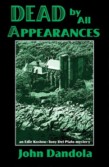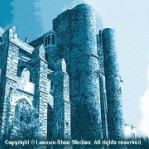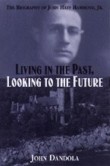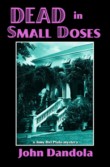

John Dandola's Hammond Castle Connection Because I have always been known to have a passion for medieval history, I got an excited invitation from two college friends who lived in the Boston area to visit a museum they had discovered on Cape Ann. The museumHammond Castle Museumhad originally been built as a private residence which replicated a European castle overlooking the sea! I fell in love with the place only to be further intrigued by is builder, John Hays Hammond, Jr. "The Father of Radio Control." As it turned out, at the age of twelve, Hammond had visited Thomas Edison's West Orange laboratories and became friendly with Edison's youngest son, Teddy. The friendship remained into adulthood and Teddy and his wife often visited Hammond's castle on the way to their summer home in Maine. Since my grandfather had been a personal messenger boy to Thomas Edison and I had known Teddy Edison, it made for a rather surreal connection to Hammond. In the 1980's, I pitched an idea to the Boston-based television producers of Spenser: For Hire for me to adapt the Spenser novel, The Godwulf Manuscript, and set it at Hammond Castle. Unfortunately, an abrupt change in producers occurred shortly thereafter and the idea went aglimmering. It wasn't until I wrote my own mystery novel, Wind of Time, that I was finally able to use the locale. Not only has it now become a featured backdrop in my Wind mystery series, but the museum's director-curator asked me to write Hammond's biographyan undertaking I was immersed in for more than four years. However, once the bio was completed and ready for press, lack of cooperation from the museum's Board of Directors caused its Autumn 2002 release to be stalled indefinitely. (The Quincannon Publishing Group acquired the rights independent of the museum and the biography finally debuted in February, 2004.) For complete details, click here. Can you imagine a museum celebrating the life and works of a man but the museum gift shop doesn't sell any books about the man or the museum itself? That is the situation at Hammond Castle. All four of the Hammond books which were created under my Hammond Castle Productions banner continue to sell quite well online. That is most gratifying for me and not a terribly astute business practice for the museum. Because of the Hammond biography and my own Hammond Castle web site (click on the link at the bottom of the page), I continue to be contacted by reporters, researchers, people who have recently visited the museum, and people who are prospective visitors to the museum. They all crave more in-depth information about this quirky genius. New England remains a second home to me and I spend quite a lot of time there. Regardless of the needless conflicts with Hammond Castle's board, my Wind mystery novels will still feature the museum and two of my 1940's mystery novels involve John Hays Hammond, Jr., as a prominent character. I also lecture about Hammond. In a recent speaking engagement to a group of grammar school students, I explained about Hammond's inventions in terms they could understand. "If it was not for Mr. Hammond, you wouldn't have a remote to turn on or off your TV or to change the channels." That more than impressed them. "If it was not for Mr. Hammond, you wouldn't have the buttons on your car radio to change the stations." That, too, more than impressed them. "And when Mr. Hammond became rich from all these inventions and he built himself a home, he built himself an actual castle." To which a third-grade girl called out, "That's my kinda man!" Mr. Hammond would have been very pleased.
THE LATEST HAMMOND BIOGRAPHY NEWS Nothing is as important to a writer as his or her reputation. For a non-fiction writer, reputation is assessed by in-depth knowledge of one's subject matter and the ethics of not passing off someone else's work as one's own. A number of writers have seemed determined to toss their reputations aside by using my work. Here are three of the latest examples: On January 11 & 12 of 2007, my publisher received first a phone message, then an e-mail (both in an urgent tone) about how to purchase my biography of John Hays Hammond, Jr. The urgent tone aroused suspicion and one of the editors checked on the woman's name who was making the inquiry. The woman turned out to be a writer of biographies for grade-school students and when my publisher strung her along, she astonishingly explained that she wanted to use my Hammond biography as the basis for one of her own books. A little background: out of necessity and not by design, in the course of writing Hammond's biography, I had to amass (at my own expense) a document and photo archive which rivals and surpasses that of his museum. I am fully aware that none of the few other writings about Hammond is accurate nor is much of the information furnished to visitors at the museum. I am also the last one to have interviewed people (now deceased) who knew Hammond during his lifetime. In short, I have become, quite by accident, the Hammond expert. I have become regarded as such. His biography is, in effect, the equivalent of my Doctoral Dissertation. Mine is the only Hammond biography out there. I have been more than generous in telling this inventor's story to the world via my published works and my own Hammond Castle web site. But generosity has its limitsespecially when someone intentionally sets out to use my labors to make money for herself. When another author contacts my publisher and openly admits to wanting to use my years of research, detective work, and psychological insight as the only basis for her own intended biography of the same man, I consider such a move as not only full of brass, but it is also quite unprofessional. Think back to your schooldays when you informed your teacher that in your shortcut to complete an assigned report, you had used only one resource and that teacher promptly chided you about how using one resource is simply copying someone else's hard work. That can be expected of a child's lapse in understanding but for a "professional" author to take such a tact is dishonest. To re-write someone else's work in simpler, shorter sentences isn't authorship at all and it's inherently unethical. Writing an adaptation requires the permission and cooperation of a fully credited source. I do not begrudge anyone for attempting to write about Hammond. But do your own research! Since my work is the only accurate resource available, using my work with nothing else as cross-reference is theft. The few vintage articles and museum pamphlets which exist are all riddled with inaccuracies. Without my work, no one can produce a biography of merit about Hammond. This writer's underhanded approach was reported to her publisher. It was also reported to my attorneys. My publishers, in turn, reported it to their attorneys and my Hammond biography was not made available to her. Credit must be given to her publisher who decided not to entertain any such book proposal involving such circumstances. In January of 2008, it happened all over again in an equally suspicious manner by yet another female author. When it became clear to my publisher that the author's inquiry wasn't just about purchasing one of my titles but that it was for research which actually wound up entailing all of my Hammond books and articles, we asked for a written guarantee that all her sources be properly cited. Instead of allaying our fears, she just dodged the issue then ceased communication. My book was made unavailable for sale. She became indignant and the problem escalated. Evidently, she felt that I had no right to protect my works before an undoable problem arose at the hands of someone else. Attorneys became involved and the author and her publisher were put on notice. In June of 2013, a production company affiliated with the Travel Channel contacted me requesting permission to use my copyrighted photos of John Hays Hammond, Jr., for a telecast which was in the final stages of preparation. This is where logic and professionalism goes out the window. I am the biographer of Hammond. I am the Hammond expert. I am also a bonafide screenwritera member of the Writers Guild of America. Why on earth would a production company not contact the one and only screenwriting professional with expertise on Hammond before even planning such a broadcast? It not only calls into question their accuracy on the subject but can they not see how insulting it is to ask for use of that professional's property after excluding him from the project? The permission for use of the photos was denied and, as a safeguard, my attorneys were notified since a previous incident with a different producer at a different cable television channel involved plagiarism of my Hammond work. As a friend of mine has assessed: "Do you encourage these people or is there something about your writing that just makes you a magnet for them?" I wish I only knew. John Dandola My Hammond Castle Web Site | My Fiction Set at Hammond Castle Copyright © 20002013 John Dandola, Ltd. All rights reserved. |




